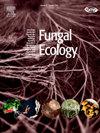Environmental heterogeneity and soil properties influence fungal communities in Amazonian ferruginous fields
IF 2.2
3区 环境科学与生态学
Q3 ECOLOGY
引用次数: 0
Abstract
Fungi are crucial for ecosystem functioning, but there is a lack of data regarding their role in tropical ferruginous ecosystems. This study aims to characterize fungal communities across a vegetation gradient in the ferricretes of the southeastern Amazon, using metabarcoding of the second subunit of the internal transcribed spacer (ITS2). Soil samples were collected from different vegetation formations from previously identified ferricretes in the Lower Araguaia Watershed, Brazil. In total, 2,237 operational taxonomic units were obtained, with a predominance of Ascomycota and Basidiomycota. The taxonomic and functional groups differed between grasslands, shrublands and adjacent forests. Saprotrophic fungi and plant pathogens are predominant across all ferricrete formations, with notable dominance of melanized fungi such as Chaetothyriales and Pleosporales that are highly tolerant to adverse environmental conditions. The distribution of fungal communities is influenced by factors such as soil pH, nutrients, and texture. These results provide new insight into the dynamics of fungal communities in ferruginous fields and their importance for the maintenance of plant communities established in Amazonian ferricretes.
环境异质性和土壤性质对亚马逊地区含铁农田真菌群落的影响
真菌对生态系统功能至关重要,但缺乏关于它们在热带含铁生态系统中的作用的数据。本研究旨在利用内部转录间隔段(ITS2)第二亚基的元条形码来表征亚马逊东南部铁细胞中不同植被梯度的真菌群落。在巴西的下阿拉瓜亚流域,从不同的植被形成中收集了土壤样本,这些植被来自先前确定的铁质沉积物。共获得2237个操作分类单位,以子囊菌门和担子菌门占优势。草地、灌丛和邻近森林的分类和功能群存在差异。腐养真菌和植物病原体在所有铁层中都占主导地位,其中显著的优势是黑化真菌,如Chaetothyriales和Pleosporales,它们对不利的环境条件具有高度的耐受性。真菌群落的分布受土壤pH、养分和质地等因素的影响。这些结果提供了新的见解,在铁田真菌群落的动态及其重要性,维持在亚马逊铁动物建立的植物群落。
本文章由计算机程序翻译,如有差异,请以英文原文为准。
求助全文
约1分钟内获得全文
求助全文
来源期刊

Fungal Ecology
环境科学-生态学
CiteScore
5.80
自引率
3.40%
发文量
51
审稿时长
3 months
期刊介绍:
Fungal Ecology publishes investigations into all aspects of fungal ecology, including the following (not exclusive): population dynamics; adaptation; evolution; role in ecosystem functioning, nutrient cycling, decomposition, carbon allocation; ecophysiology; intra- and inter-specific mycelial interactions, fungus-plant (pathogens, mycorrhizas, lichens, endophytes), fungus-invertebrate and fungus-microbe interaction; genomics and (evolutionary) genetics; conservation and biodiversity; remote sensing; bioremediation and biodegradation; quantitative and computational aspects - modelling, indicators, complexity, informatics. The usual prerequisites for publication will be originality, clarity, and significance as relevant to a better understanding of the ecology of fungi.
 求助内容:
求助内容: 应助结果提醒方式:
应助结果提醒方式:


